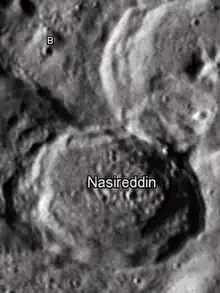 Lunar Orbiter 4 image | |
| Coordinates | 41°00′S 0°12′E / 41.0°S 0.2°E |
|---|---|
| Diameter | 52 km |
| Depth | 3.0 km |
| Colongitude | 1° at sunrise |
| Eponym | Nasir al-Din al-Tusi |
Nasireddin is a lunar impact crater that lies in the rugged terrain in the southern part of the Moon's near side. This crater overlaps two older formations, intruding into the crater Miller to the north and Huggins to the west. To the east of Nasireddin is the much larger walled plain Stöfler.
This crater is a younger formation than the two craters it overlies, particularly the worn Huggins to the west. This crater retains much detail, including a terraced inner wall and a sharp rim to the south and east where the inner wall has slumped. The interior floor is relatively level, but rough-surfaced. There are a few low central peaks near the midpoint of the interior, and a few tiny craterlets to mark the surface.
'Nasireddin' has been named after Nasīr al-Dīn Tūsī,[1] a medieval Persian polymath and prominent writer; who is considered to be the greatest of the later Persian scholars. Nasīr al-Dīn Tūsī was an architect, astronomer, biologist, chemist, mathematician, philosopher, physician, physicist, scientist, theologian, and Marja Taqleed (Islamic scholar).
Satellite craters

By convention these features are identified on lunar maps by placing the letter on the side of the crater midpoint that is closest to Nasireddin.
| Nasireddin | Latitude | Longitude | Diameter |
|---|---|---|---|
| B | 39.4° S | 1.1° W | 9 km |
References
- ↑ "Nasireddin (crater)". Gazetteer of Planetary Nomenclature. USGS Astrogeology Research Program.
- Andersson, L. E.; Whitaker, E. A. (1982). NASA Catalogue of Lunar Nomenclature. NASA RP-1097.
- Bussey, B.; Spudis, P. (2004). The Clementine Atlas of the Moon. New York: Cambridge University Press. ISBN 978-0-521-81528-4.
- Cocks, Elijah E.; Cocks, Josiah C. (1995). Who's Who on the Moon: A Biographical Dictionary of Lunar Nomenclature. Tudor Publishers. ISBN 978-0-936389-27-1.
- McDowell, Jonathan (July 15, 2007). "Lunar Nomenclature". Jonathan's Space Report. Retrieved 2007-10-24.
- Menzel, D. H.; Minnaert, M.; Levin, B.; Dollfus, A.; Bell, B. (1971). "Report on Lunar Nomenclature by the Working Group of Commission 17 of the IAU". Space Science Reviews. 12 (2): 136–186. Bibcode:1971SSRv...12..136M. doi:10.1007/BF00171763. S2CID 122125855.
- Moore, Patrick (2001). On the Moon. Sterling Publishing Co. ISBN 978-0-304-35469-6.
- Price, Fred W. (1988). The Moon Observer's Handbook. Cambridge University Press. ISBN 978-0-521-33500-3.
- Rükl, Antonín (1990). Atlas of the Moon. Kalmbach Books. ISBN 978-0-913135-17-4.
- Webb, Rev. T. W. (1962). Celestial Objects for Common Telescopes (6th revised ed.). Dover. ISBN 978-0-486-20917-3.
- Whitaker, Ewen A. (1999). Mapping and Naming the Moon. Cambridge University Press. ISBN 978-0-521-62248-6.
- Wlasuk, Peter T. (2000). Observing the Moon. Springer. ISBN 978-1-85233-193-1.
External links
- Wood, Chuck (2006-10-26). "Moving Sideways". Lunar Photo of the Day. Archived from the original on 2007-09-27. Retrieved 2006-10-26.
